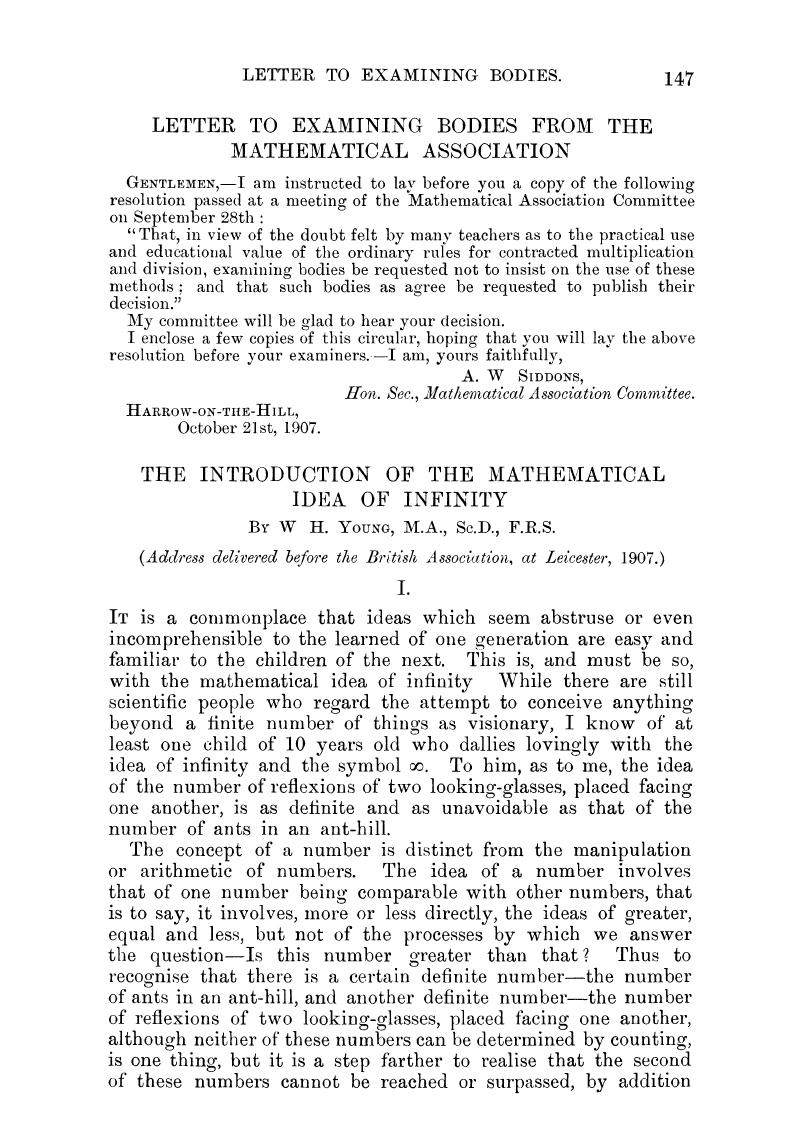No CrossRef data available.
Article contents
The Introduction of the Mathematical Idea of Infinity
Published online by Cambridge University Press: 03 November 2016
Abstract

- Type
- Other
- Information
- Copyright
- Copyright © Mathematical Association 1907
References
page 148 note * Actually very much less, I believe.
page 150 note * Instead of saying:

Examples might be multiplied, but it is not only that we have here a more handy form of statement, we are enabled to discuss simultaneously a number of special cases, and so to avoid the tedious repetition of arguments in which no new idea is introduced, and which therefore render the subject unnecessarily tedious. A good example of this is the celebrated theorem that, if the corresponding sides of two triangles ABC and A′B′C′ meet on a straight line, then the rays joining corresponding points, AA′, BB′, CC′, meet at a point, and vice versa.
page 151 note * I am glad to say that circulating decimals have no longer the prominence in the ordinary curriculum that they enjoyed when I was a boy. We must not, however, entirely banish them, or fail to assign to them their proper place, when devising our logical scheme of education.
page 152 note * A rational number is the general term for any integer or fraction. An irrational number is then, in the first instance, the negation of the rational, and is subsequently used for any of the new numbers conventionally introduced.
page 153 note * The irrational point P, corresponding to the irrational number ![]() is constructed without the use of intervals as the intersection of two straight lines. It cannot be proved that this is the case with any irrational number, and it is known that in the case of some irrational numbers, e.g. the length of the circumference of a circle of diameter unity, the construction (so called “squaring of the circle”) cannot be carried out by means of ruler and compasses. It is assumed as an axiom in the theory of sets of points that every irrational number, by whatever mathematical process it is obtained or defined, determines a point on the straight line.
is constructed without the use of intervals as the intersection of two straight lines. It cannot be proved that this is the case with any irrational number, and it is known that in the case of some irrational numbers, e.g. the length of the circumference of a circle of diameter unity, the construction (so called “squaring of the circle”) cannot be carried out by means of ruler and compasses. It is assumed as an axiom in the theory of sets of points that every irrational number, by whatever mathematical process it is obtained or defined, determines a point on the straight line.
page 154 note * P may, or may not, belong to the set, according as the set is defined. Thus any point is a limiting point of the rational points, but it only belongs to the set if it is itself a rational point
page 155 note * For instance the area 2 sq. metres may be plotted down as the point whose distance from the zero point is 2 millimetres, and so on.
page 155 note † Plotting down the points ![]() and so on taking each time one more term into the sum, we get on the straight line points, which soon, within the limits of vision, are indistinguishable from the point 1; this point 1 is in fact the limiting point of the set and the number 1 is the limit of the set of numbers. The successive sums of the second series are plotted down as the left-hand end-points of the intervals of § VI., which, as we saw, shrank up to the point
and so on taking each time one more term into the sum, we get on the straight line points, which soon, within the limits of vision, are indistinguishable from the point 1; this point 1 is in fact the limiting point of the set and the number 1 is the limit of the set of numbers. The successive sums of the second series are plotted down as the left-hand end-points of the intervals of § VI., which, as we saw, shrank up to the point ![]() , and the whole infinite series is only another way of writing the circulating decimal 3.
, and the whole infinite series is only another way of writing the circulating decimal 3.
page 157 note * This is quite distinct from two simple limits in succession.
page 158 note * It may be added that such a definition shirks the real difficulty. The triple integrals may indeed not exist.




